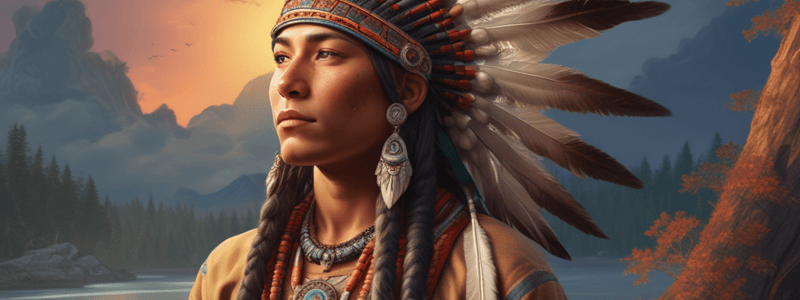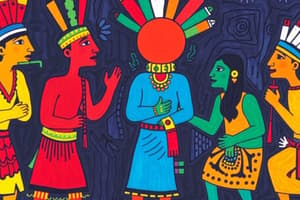Podcast
Questions and Answers
What method did Christian Converters use to convert more of the Native population?
What method did Christian Converters use to convert more of the Native population?
- Healing practices (correct)
- Offering material goods
- Threatening to take away their land
- Using force and violence
How were the dead buried by the Wampanoag Tribe?
How were the dead buried by the Wampanoag Tribe?
- In the fetal position facing southwest (correct)
- Sitting upright facing east
- Lying on their back facing up
- In a standing position facing north
What practice did the Wampanoag Tribe follow during burials?
What practice did the Wampanoag Tribe follow during burials?
- Including personal items for the afterlife (correct)
- Burying the deceased with no belongings
- Burning the deceased's belongings
- Performing elaborate rituals over the grave
What made it easier for the Natives to accept conversion to Christianity?
What made it easier for the Natives to accept conversion to Christianity?
How did the Colonial Converters view Native supernatural practices?
How did the Colonial Converters view Native supernatural practices?
What did the Wampanoag Tribe do with their supernatural practices after conversion?
What did the Wampanoag Tribe do with their supernatural practices after conversion?
What was the purpose of English Preachers striving to increase literacy among the Natives?
What was the purpose of English Preachers striving to increase literacy among the Natives?
What effect did books like The Indian Primer have on the Native population?
What effect did books like The Indian Primer have on the Native population?
What did both New England Christians and Native American Christians seek in terms of spiritual practices?
What did both New England Christians and Native American Christians seek in terms of spiritual practices?
What was the concern of colonial preachers regarding Native healing practices?
What was the concern of colonial preachers regarding Native healing practices?
What was observed about the literacy rate among the Native population over time in Plymouth Colony?
What was observed about the literacy rate among the Native population over time in Plymouth Colony?
What term describes the shift from the production to the consumption of religious values mentioned in the text?
What term describes the shift from the production to the consumption of religious values mentioned in the text?
What was the primary focus of the article?
What was the primary focus of the article?
What was the role of the native preachers in the early churches for converted natives?
What was the role of the native preachers in the early churches for converted natives?
How did the conversion of the natives to Christianity affect their families?
How did the conversion of the natives to Christianity affect their families?
What was the primary goal of Josiah Cotton's missionary work?
What was the primary goal of Josiah Cotton's missionary work?
What did the article say about the spirituality of the native tribes?
What did the article say about the spirituality of the native tribes?
What type of individuals were marginalized and collectively referred to as 'suku'?
What type of individuals were marginalized and collectively referred to as 'suku'?
How did males gain entrance to the 'Kuksu cult' according to the text?
How did males gain entrance to the 'Kuksu cult' according to the text?
What characterized the winter dances sponsored by the 'Kuksu cult'?
What characterized the winter dances sponsored by the 'Kuksu cult'?
In which villages did Maidu women have authority over the society and its ceremonies?
In which villages did Maidu women have authority over the society and its ceremonies?
What was true about women's initiatory statuses in both Foothills and Valley villages according to the text?
What was true about women's initiatory statuses in both Foothills and Valley villages according to the text?
What is the significance of the boys' 'yambasi' initiation mentioned in the text?
What is the significance of the boys' 'yambasi' initiation mentioned in the text?
What was the primary function of the Maidu Clown?
What was the primary function of the Maidu Clown?
What distinctive physical characteristics helped identify the Maidu Clown?
What distinctive physical characteristics helped identify the Maidu Clown?
Where did the Maidu Clown typically perform during ceremonies?
Where did the Maidu Clown typically perform during ceremonies?
What type of comedy was associated with the Maidu Clown's performances?
What type of comedy was associated with the Maidu Clown's performances?
Which of the following was NOT a characteristic associated with the Maidu Clown?
Which of the following was NOT a characteristic associated with the Maidu Clown?
How did the Maidu Clown's comedy vary across different regions?
How did the Maidu Clown's comedy vary across different regions?
What was the primary subsistence practice of the Maidu people prior to European contact?
What was the primary subsistence practice of the Maidu people prior to European contact?
Which of the following best describes the social structure of the Maidu people?
Which of the following best describes the social structure of the Maidu people?
What was the relationship between the Foothill and Valley regions of the Maidu territory?
What was the relationship between the Foothill and Valley regions of the Maidu territory?
Which of the following best describes the Maidu Salmon Ceremony?
Which of the following best describes the Maidu Salmon Ceremony?
What is the significance of the term 'triblet' in describing the Maidu social structure?
What is the significance of the term 'triblet' in describing the Maidu social structure?
What was the basis for the material wealth of the Maidu elite?
What was the basis for the material wealth of the Maidu elite?
Which of the following was NOT mentioned as a type of wealth object used by the Maidu?
Which of the following was NOT mentioned as a type of wealth object used by the Maidu?
What was the primary role of the village headman (huku or yeponi) among the Maidu?
What was the primary role of the village headman (huku or yeponi) among the Maidu?
What was the relationship between the elite and commoner status groups in Maidu society?
What was the relationship between the elite and commoner status groups in Maidu society?
What was the role of the village priest-shaman (yukbe) in Maidu society?
What was the role of the village priest-shaman (yukbe) in Maidu society?
Which of the following was NOT mentioned as a type of material used in Maidu ceremonial clothing?
Which of the following was NOT mentioned as a type of material used in Maidu ceremonial clothing?
What was the main role of the Maidu clown in the community?
What was the main role of the Maidu clown in the community?
What is the significance of the Maidu clown jokingly referred to as 'morning speech'?
What is the significance of the Maidu clown jokingly referred to as 'morning speech'?
What differentiated the 'bums' described in the text from other societal members?
What differentiated the 'bums' described in the text from other societal members?
How did the Maidu clowns contribute to societal balance according to the text?
How did the Maidu clowns contribute to societal balance according to the text?
What characteristic behavior did 'brumui', as described in the text, display?
What characteristic behavior did 'brumui', as described in the text, display?
In the context of the Maidu clown, what aspect of their behavior is highlighted by Shakespeare's Olivia quote 'no slander in an allowed fool'?
In the context of the Maidu clown, what aspect of their behavior is highlighted by Shakespeare's Olivia quote 'no slander in an allowed fool'?
Flashcards are hidden until you start studying




